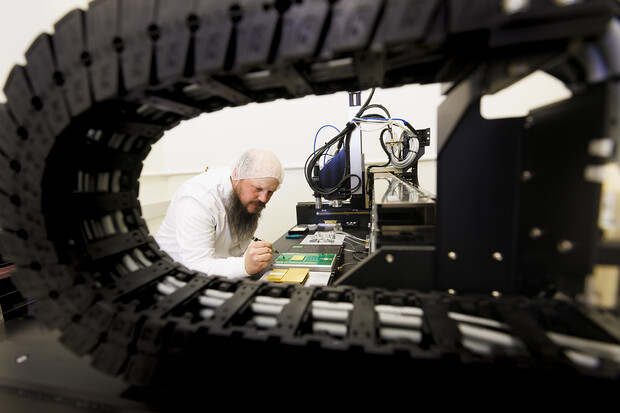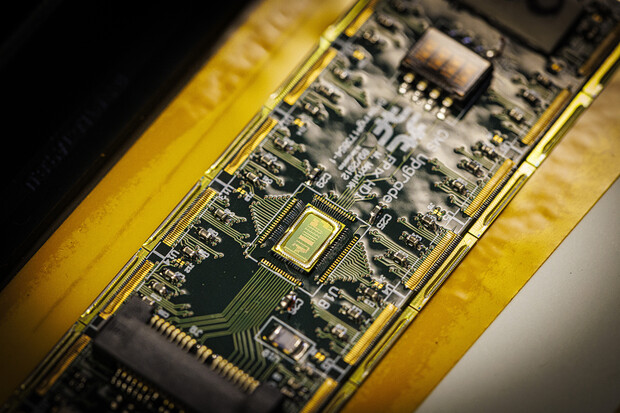Leslie Reed, May 25, 2022
Husker’s career shaped by the Large Hadron Collider
Caleb Fangmeier grew up fixing tractors and implements on a farm near Hebron, Nebraska. Today, as Detector Laboratory manager for the University of Nebraska–Lincoln’s high energy physics group, he is in charge of manufacturing high-tech parts for the world’s largest and most powerful atom smasher, the Large Hadron Collider (LHC).
Although he’s seen the mammoth facility located on the border of France and Switzerland only once, during a tour, the Large Hadron Collider has been a continuous force throughout Fangmeier’s academic studies and working life.
A major highlight of Fangmeier’s undergraduate study came in July 2012, when the discovery of the Higgs boson was announced.
“I stayed up until after two in the morning our time to watch the live webcast of the announcement,” he said. “It was big news.”
The Higgs boson is a fundamental particle that had been theorized, but not confirmed, for nearly 50 years. Its discovery is important to the Standard Model, the broadly accepted explanation for how the basic building blocks of matter interact. It signals the existence of the Higgs field, an invisible energy field present throughout the universe that imbues other particles with mass.
Some compared its discovery to landing a man on the moon.
“The discovery had been anticipated for years,” Fangmeier said. “I had been in Switzerland for an undergraduate research program the year before and everyone was buzzing about ‘when are we going to have the Higgs?’ At that point, there were some hints in the data that there was something real, but nobody knew what it was for sure.”

The Large Hadron Collider is a 17-mile circular underground tunnel filled with superconducting magnets, with two high-energy particle beams that travel at close to the speed of light before they are made to collide. Eight particle detectors, called “experiments,” are in place along the ring to detect and analyze the behavior of the new particles resulting from the collisions. The Compact Muon Solenoid (CMS), which is the only experiment with which Nebraska scientists are involved, is one of two large general-purpose particle detectors that have been in place since day one.
The discovery of the Higgs felt particularly significant because so many of Fangmeier’s Nebraska professors have been intrinsically involved in particle physics work related to the LHC, people like the late Greg Snow, who died in 2019; Aaron Dominguez, now provost and physics professor at The Catholic University in Washington D.C.; Ken Bloom, recently assigned management of National Science Foundation funding for CMS operations; Frank Golf and Ilya Kravchenko, who oversee the Detector Laboratory; Dan Claes, who performs experiments using the CMS and Peisi Huang, who does theoretical physics work related to CMS.
Fangmeier himself has been involved with the LHC since “phase zero” — the first version of the CMS detector, in use when the LHC started up in 2008.
The collider first became operational about the time the Thayer Central High School graduate arrived at the university with a full-tuition Regents Scholarship and career decisions to make.
“I didn’t really envision a career like this when I was really young,” he said. “I was more interested in being the class clown than paying attention. In junior high, I found science and that interested me. At that point, I was envisioning engineering more than being an academic scientist.”
Though he was interested in both physics and engineering, he decided to declare a physics major. During his first year, he began working in Dominguez’s laboratory.
“I started taking physics classes and did a little bit of physics research, and I got hooked on it.”
“We were analyzing data collected through that detector and the properties of its performance,” he said. “I added a double major in computer science in my third year and that really helped. To do any of this stuff, you have to have some programming chops.”
In summer 2011, Fangmeier was one of five students chosen through the National Science Foundation’s Partners for International Research and Education program to spend the summer at the Paul Scherrer Institute, located about 165 miles from CERN (European Council for Nuclear Research), where the Large Hadron Collider is located.
He and the other students were given a tour of the CERN laboratories while they were in Switzerland.
As a graduate student, he helped build modules for the Phase I upgrade of the CMS detector, used during the LHC’s successful second run, which ended in December 2018. He programmed a gantry, a small robot used to precisely glue layers of computer chips and sensors together to create a module that can detect subatomic particles and interface with the resulting data.
The software Fangmeier developed to deploy the gantry is now in use at five U.S. institutions, including Nebraska.

For his doctoral dissertation, he analyzed data collected in Run 2, from 2015 to 2017. He came close, but didn’t have quite enough data to confirm another long-theorized part of the Standard Model, that colliding protons can produce as many as four top quarks. He predicts the run that begins this summer will produce enough data to confirm the four top quarks.
Fangmeier and his team now are preparing Phase II upgrades of the CMS, to be deployed for the LHC’s fourth run, which will occur in 2029 or later.
Most of their work is for the tracker, the innermost part closest to the interaction regions. Recently the lab has also been working on another part of the CMS, called the timing detector. Its job is to take extremely precise timing measurements of when particles go through a certain position.
He and his team, most of them undergraduate students, will build about 2,500 of the modules by 2026.
Even though a decade has now lapsed since the discovery of the Higgs Boson, Fangmeier is confident more amazing discoveries soon lie in store for the LHC.
“You only discover fundamental particles once,” he said. “Eventually we’ll find them all, and to be alive when we’re making these discoveries is pretty amazing.”





